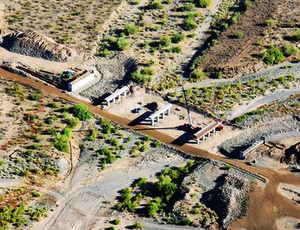A vocal group of local residents has spurred a debate over the route of a new, seven-mile stretch of road in north Phoenix being built to access an area of Sonoran Desert preserve. Opponents claim the new thoroughfare will draw unwanted traffic to a quiet neighborhood.

The Phoenix City Council on June 14 placed construction of the contentious west third of the project on temporary hold, pending mediation. Work resumed on July 6, with the city aiming to accelerate funding for alternate routes and to recommend changes to speed limits, among other modifications, says Wylie Bearup, Phoenix street transportation director.
Along with the two-lane roadway, construction includes a 4.5-mile bike and pedestrian path that will meander through the preserve. Haydon Building Corp., Phoenix, was selected for the $42-million construction manager-at-risk contract to build the road and path and also to bury a stretch of pre-existing 69KV cabling. Work began in August 2010 and involved salvaging and storing more than 1,000 desert trees and cacti, many of which were protected saguaro.
Bearup says the road “was never intended to be a major arterial across this area,” but was designed to provide recreational access and to follow the city's right-of-way development guidelines for new alignments.
While the project was well received during an extensive public outreach campaign from 2002 and 2005, “there are things we could have done better and changes we are going to make in our public involvement process as we move forward,” Bearup says. The problems stemmed from new residential developments that did not become occupied until after public input ceased. Once construction began, these new residents raised concerns about increasing traffic in their neighborhood.
Despite the temporary hold on construction on the project's west side, Bearup says Haydon was able to continue work in other areas. This included construction of the structural elements required for 10 prefabricated steel pedestrian bridges, 23 box culverts and three traffic bridges—the longest at 429 ft.
As the largest CMAR project to date for the city, the scheme combines three separately designed sections. The western third has the majority of cut in the project, totalling 400,000 cu yd of material that, under the single CMAR contract, can be hauled and used in the eastern segment, which is mostly composed of fills, says Troy Gjerde, Haydon project manager. This helped save 20% of the cost of doing the project in three separate phases, says Shane Silsby, deputy director.
With a total of 800,000 cu yd of earthwork, Haydon used Agtek Earthwork 3D and Materials 3D software to build a robust model to create color-coded cut/fill maps, set grades and control machinery, says Joseph Grant, Haydon's estimating engineer.
“Because of the model, we found the plan specifications were shy by 80,000 cubic yards prior to us going into the project. So it was a benefit to us and the city to spend the time creating the model,” Gjerde says.
In an effort to spend construction dollars locally, all 44 subcontractors on the job are based in the Phoenix area, Gjerde says. The project is on track for a May 2013 completion.


Post a comment to this article
Report Abusive Comment